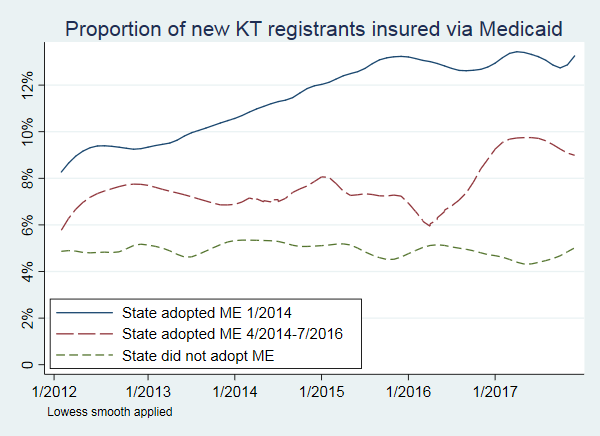Increased Access to Transplantation for Medicaid Patients Following Medicaid Expansion
Johns Hopkins, Baltimore, MD
Meeting: 2019 American Transplant Congress
Abstract number: 286
Keywords: Kidney
Session Information
Session Name: Concurrent Session: Quality Assurance Process Improvement & Regulatory Issues I
Session Type: Concurrent Session
Date: Monday, June 3, 2019
Session Time: 2:30pm-4:00pm
 Presentation Time: 3:30pm-3:42pm
Presentation Time: 3:30pm-3:42pm
Location: Room 210
*Purpose: Under the Patient Protection and Affordable Care Act (ACA), states in the United States had the option of expanding Medicaid eligibility. 24 states adopted Medicaid expansion (ME) on 1/1/2014; another 12 adopted Medicaid expansion through 7/1/2016. The effect of ME on access to kidney transplantation (KT) for patients with ESRD is unknown.
*Methods: Using SRTR data 2012-2017, we assessed the proportion of new US-resident deceased donor KT registrants over time who were insured via Medicaid in ME and non-ME states. Additionally, we used generalized estimating equations to model the change in center-level incident waitlist registration of Medicaid and non-Medicaid patients associated with ME.
*Results: Of 216,903 KT registrants 2012-2017, 50.9% lived in a state that adopted ME on 1/1/2014, 11.6% lived in a state that adopted ME between 4/2014-7/2016, and 37.5% lived in a state that did not adopt ME. The proportion of new registrants insured with Medicaid increased from 9.5% 2012-2013 to 11.2% in 2014 and 12.9% 2015-2017 in states that adopted ME on 1/1/2014 (chi2 p<0.001) but remained constant in states that did not adopt ME (4.9%/5.1%/4.9%, p=0.3) (Figure). Among new registrants who received living donor KT within 18 months of registration, the proportion insured with Medicaid increased from 5.8% in 2012-2013 to 6.7% in 2014 and 9.1% 2015-2017 (p<0.001); in all eras this proportion was 3.3% in states that did not adopt ME (p=0.9).
Compared to states that did not adopt ME, transplant centers in states that adopted ME had a 21% increase in new adult registrants insured via Medicaid in the first year following ME (IRR=1.17 1.21 1.26, p<0.001) and a 40% increase thereafter (IRR=1.36 1.40 1.45, p<0.001). Additionally, centers in states that adopted ME had a nonsignificant 10% increase in new pediatric registrants insured via Medicaid in the first year following ME (IRR=0.95 1.10 1.26, p=0.2) and a 26% increase thereafter (IRR=1.13 1.26 1.40, p<0.001).
*Conclusions: In states that adopted ME, the proportion of new waitlist registrants insured via Medicaid increased substantially, and transplant centers in these states had large increases in new Medicaid registrants. ME may have expanded access to waitlisting and transplantation in states that adopted ME.
To cite this abstract in AMA style:
Massie A, Henderson M, Hwee T, Segev D. Increased Access to Transplantation for Medicaid Patients Following Medicaid Expansion [abstract]. Am J Transplant. 2019; 19 (suppl 3). https://atcmeetingabstracts.com/abstract/increased-access-to-transplantation-for-medicaid-patients-following-medicaid-expansion/. Accessed December 10, 2025.« Back to 2019 American Transplant Congress

